The Desktop Kabini Review Part 1: AMD Athlon 5350 (AM1) Tested
by Ian Cutress on April 9, 2014 8:00 AM ESTIGP Comparison, Synthetics
AMD’s graphics stack from top to bottom is all based on the Graphics Core Next architecture. This is an update from earlier VLIW implementations, offering for scalability from low power all the way up to high performance. At the heart of an AMD graphics system is the compute unit comprising of 64 GPU cores. Each compute unit can act independently, ensuring that multiple tasks can complete as quickly as possible due to multiple kernel dispatch across the entire core. In the Kaveri APU launch we were dealing with APUs that contained 6 or 8 compute units for 384/512 cores. With this level of performance, gaming at 1080p30 was possible on most titles depending on how the quality settings were configured. For Kabini, the entire range is given two compute units, with individual processors differing in clock speed.
With two compute units, we are not expecting much from the gaming aspect of these APUs in terms of ‘the latest’ titles. Our benchmarks in the next few pages show that even F1 2013 at 1280x1024 on low settings, unless the engine powering the game is basic, 25 FPS minimum is a hopeful target. This lack of horsepower may limit these APUs to Flash based titles, perhaps even some of the more reasonable Unity games. In AMD’s slide deck they quote games such as Minecraft, Lego Marvel Superheroes and Bastion as the sort of titles that a Kabini player should aim for.
There is some confusion regarding the naming convention of these integrated graphics solutions. Soldered on Kaveri parts designed for all-in-ones, such as the A6-5200, use the HD8000 naming scheme, such as the HD8400. The Athlon 5350 is analogous in design to the A6-5200 except for a 50 MHz speed bump and the name of the IGP – here this is designated as the R3 series. This is despite retailers who are currently selling this APUs and labeling them with the HD8000 designations.
Like Kaveri, the integrated graphics solution in Kabini features an updated Video Codec Engine and Unified Video Decoder giving hardware support for H.264.
AMD is also promoting their Picture Perfect solution, using additional post processing tools to increase video quality on the fly:
Also rather interestingly AMD is claiming an enhanced decoder for JPEG files. Given that one of the primary uses for a Kabini system might be for web access where JPEGs are standard, AMD has been promoting up to a 2x performance increase over a J2900 system:
AMD’s secret sauce, according to their slides, appears to be heterogeneous computing. This would be the ideal usage scenario for computing going forward.
GPU Synthetics
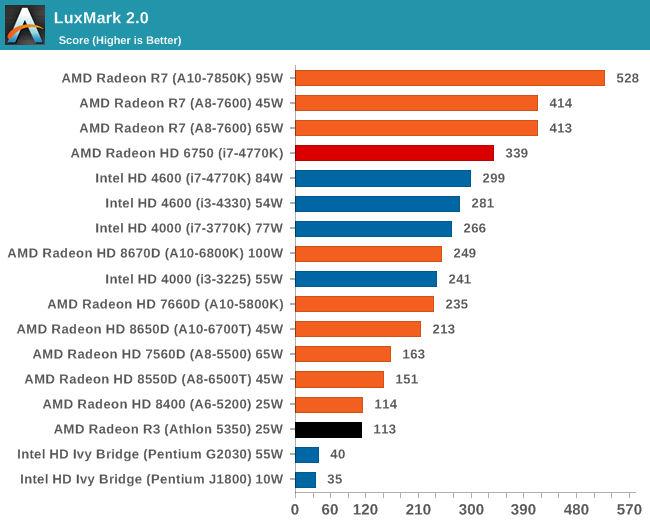
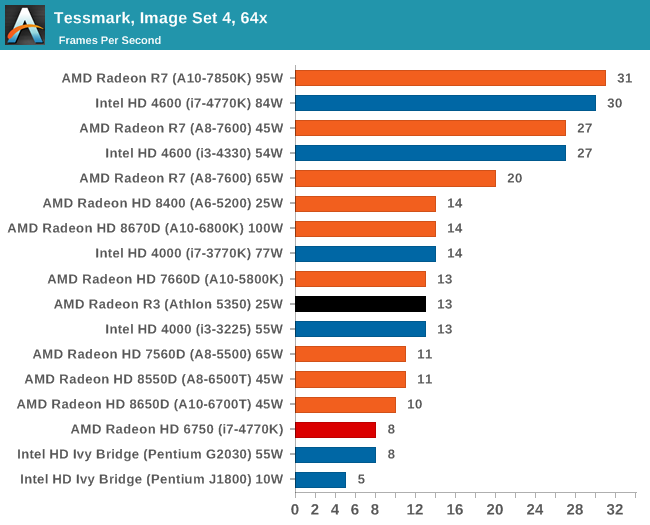


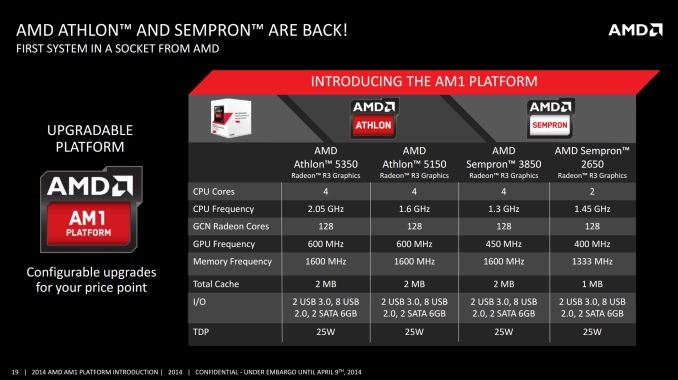
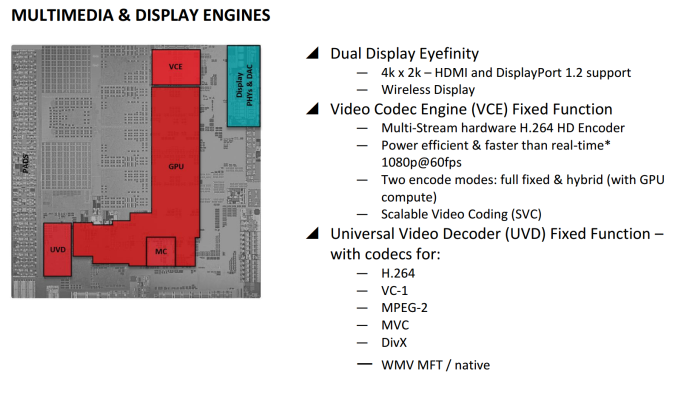
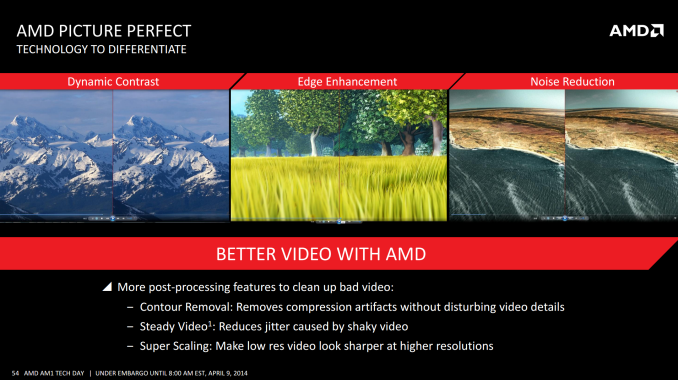
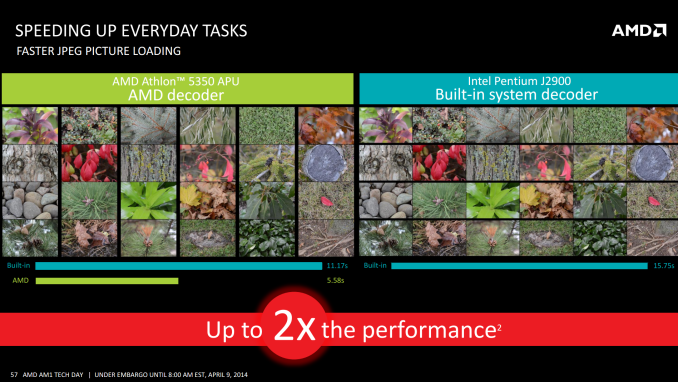
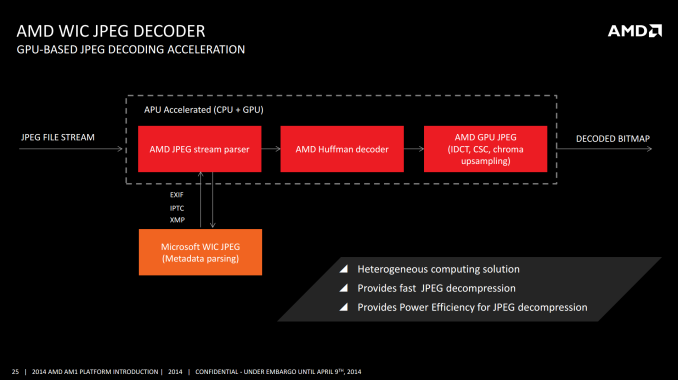








126 Comments
View All Comments
jabber - Wednesday, April 9, 2014 - link
Yep slap a 120GB SSD in there and you have a nice little office system for not a lot of outlay. Doesnt matter if its SATA2, its all in the access times.meacupla - Wednesday, April 9, 2014 - link
what would be nice is high bit rate software 1080p playback, for when DXVA doesn't work.I remember my E-350 getting choppy on those.
Medallish - Wednesday, April 9, 2014 - link
Well the one I built feels pretty responsive, even with a mechanical drive. You do need to install the drivers, but once they were on there it didn't feel at all sluggish, I tried loading up a bunch of heavily advertised pages on chrome, and didn't really notice any impact on performance. I must admit I haven't tried any 1080p Youtube videos, but I will give those a go, I imagine it runs fine, I had a Quad Core "Phenom II" Mobile CPU that ran 2GHz, performance should be pretty close to this I imagine. And yeah I did a test on that running a youtube video @ 1080p and a 1080p video on VLC at the same time, now this was running a 6670m which is bound to be a lot better than this, but the CPU wasn't holding it back atleast.gandergray - Wednesday, April 9, 2014 - link
Hello Ian. Thank you for the article. In the second to last sentence of the paragraph that follows the Athlon v. Celeron table in the “Competition” section, the word “subsiding” should be “subsidizing”.JDG1980 - Wednesday, April 9, 2014 - link
The Cinebench 10 benchmark indicates that Kabini's IPC is only slightly below that of Intel's old Conroe architecture (E2180, running at the same 2GHz clock speed). For such a small die and low TDP, that's actually pretty good. Integer IPC seems to be better than Intel's Baytrail series, though floating-point lags a bit (at least if 3D Particle Motion is a good test - never heard of it before).IPC for AMD's big cores is still not much better than Conroe, and lags behind Nehalem. Steamroller was supposed to help, but didn't do much for IPC (even though it did reduce the CMT penalty). This calls into question why AMD's 'construction equipment' cores are even still being developed. If the small 'cat' cores can do as well as they do with only a dual-issue front end, and a bunch of other missing optimizations (e.g. no decoded micro-op cache), then beefing up the basic design for desktop/server use would probably beat Steamroller in IPC while having lower power usage. It wouldn't close the gap with Intel's big cores, but it would at least provide a solid foundation to build on. This would be the same thing Intel did themselves back when they ditched the unviable Netburst design in favor of one derived from the mobile Pentium-M.
mrdude - Wednesday, April 9, 2014 - link
Yea, I think many people would agree with you. I like the Jaguar architecture quite a bit, as it seems to be very well balanced. The 4-way shared L2 and integer performance seem like very solid foundations to build upon. The fact that it has AVX whereas Intel's Atoms and low end Celerons don't is also an awesome feature....but it has no turbo. AMD's turbo core is actually really advanced, dynamically adjusting clock speeds and voltages depending on the CPU or GPU load or both. Even the steaming pile of poo that was Bulldozer had a great turbo, but for some reason AMD decided not to dedicate the resources and engineering talent to fit Kabini with the same feature.
I'd love to see AMD dump the construction line and work on something similar to Jaguar that scales upward and wider more easily. It might not be a monster, but at least it offers decent perf-per-watt.
errorr - Wednesday, April 9, 2014 - link
Pretty sure the 3d particle motion test was written by Ian and I vaguely recall it being related to his PhD Thesis.lever_age - Wednesday, April 9, 2014 - link
Just a small suggestion, but for comparative performance tables like the one on the last page, could you mark benchmarks by whether a higher or lower number is better (like on the larger graphs)? I guess this could be done either in the margin by the benchmark name or by coloring the winning column.mr_tawan - Wednesday, April 9, 2014 - link
Looks a lot like P3 or Athlon board to me, especially when the cpu+cooler is installed. Feel nostalgic.errorr - Wednesday, April 9, 2014 - link
Well except the lack of North Bridge and no diarrhea brown AGP slot.